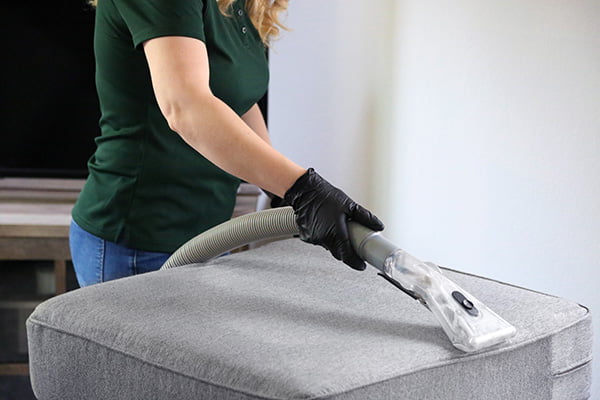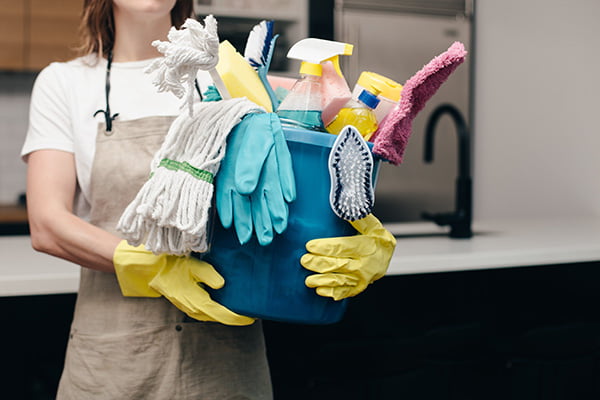When it comes to couch and armchair fabrics, microfiber is a popular favorite. This is particularly true in homes with pets and kids, as microfiber is stain-resistant, durable, and resilient! Furthermore, its velvety and opulent texture provides a soft tactile experience reminiscent of luxurious suede.
However, every furniture piece needs regular cleaning, and despite the stain resistance of microfiber, stains happen from time to time. This fabric has a few cleaning considerations to keep in mind, but with a few special steps, it's easy to manage!
Keep reading to learn how to clean your microfiber couch, how to treat common stains, and what to do to keep your couch looking smooth and spotless in between cleanings!
What Is Microfiber?
The microfiber fabric used in towels differs from that used in furniture upholstery. Towels use a blend of microfibers and synthetic fibers, which helps them stand up to rigorous cleaning and hot water cycles in the washing machine. Couches are made of 100% microfibers, with no blend of other fabrics. They are designed not to need to be washed often and should never go through dry cleaning. However, it's easy to clean a microfiber couch, even with those restrictions!
Know Your Cleaning Code
Among microfiber couch fabrics, there are slight variations that make a big difference in the cleaning process! Look on your specific microfiber couch for a cleaning or care tag. You may need to look inside the cushion covers for this tag! Once you've found it, check the code. If your tag has been removed, check the manufacturer's instructions online.
- Code W: The W signifies that water-based cleaners (and plain old soapy water) are safe to use.
- Code S: A solvent-based cleaner is safe on care tags marked with an S. These are cleaners such as rubbing alcohol.
- Code W-S: If you know what the W and S stand for, you have likely already guessed that the W-S code means that both water-based and solvent-based cleaners are fine to use! You may see this code in any order of the two letters, with or without the hyphen.
- Code X: It's unlikely that you will see this code, but the X signifies that no cleaner of any kind should be used on this fabric.

Image Source: Unsplash
How To Clean Microfiber Couch
Vacuum The Couch
Couches and sofas tend to hide all manner of crumbs, coins, and other bits of debris! It's necessary to remove these large pieces first. If the seat cushions of your microfiber couch are removable, remove them and use your vacuum to clean the fabric base of the furniture. Otherwise, the crevice tool of your vacuum cleaner is ideally suited to cleaning between permanently attached cushions! Switch to the soft brush attachment to vacuum dust and dirt from the couch's surface.
To thoroughly deep clean a microfiber couch, sprinkle the couch with a dusting of baking soda about 30 minutes prior to vacuuming to help remove unpleasant odors that can get trapped in the fibers.
Mix The Cleaning Solution
Fill a spray bottle with the cleaner that suits your microfiber couch fabric. Either use rubbing alcohol mixed with warm water or fill the bottle with a soapy mixture of warm water and your choice of dish soap.
Spray The Solution
Use the spray bottle to mist the fabric of the entire couch, concentrating on stained areas. Using a small circular motion, gently scrub the solution into the fabric using a microfiber cleaning cloth. Feel free to repeat this step as often as needed to clean your microfiber cloth couch thoroughly.
A little tip, particularly if you are using rubbing alcohol - not all cleaning cloths are color-fast when exposed to solvents! Opt for using a white cloth to rub the rubbing alcohol spray into the fabric, or you might notice the color of your cleaning cloth leeching onto your couch cushions!
Dry
Allow the microfiber furniture to dry. This can take some time, so be patient! Many microfiber couch owners opt to scrub their couches at the end of the day so that they can dry overnight.
Brush The Fibers
The fabric will feel stiff to the touch. Use a fabric brush, other soft-bristled brush, or even your hand to rub the fibers back and forth, loosening them up after cleaning.
Removing Stains From Microfiber Upholstery
To remove stains from microfiber upholstery it requires careful and gentle techniques to avoid damaging the fabric. Here's a step-by-step guide to help you remove various types of stains from microfiber upholstery:
General Tips:
- Always check the manufacturer's cleaning codes before attempting any cleaning. Common codes are "W" for water-based cleaners and "S" for solvent-based cleaners.
- Before applying any cleaning solution, make sure to test it in a hidden or inconspicuous area to ensure that it doesn't lead to discoloration or harm.
- Opt for a white or light-colored cloth when cleaning to prevent the transfer of dye from the fabric to the upholstery.
Water-Based Stains (Code "W"):
Examples: Water-based spills, juice, coffee, tea, etc.
- Gently blot the stain using a clean and absorbent cloth to extract as much liquid as possible. Avoid rubbing the stain, as this action could cause it to spread.
- Combine a small quantity of gentle liquid soap, such as dish soap, with water to formulate a cleaning solution.
- Immerse a clean cloth or sponge into the solution and then squeeze out any excess moisture. Delicately blot the stain, starting from the outer edges and moving toward the center. Keep blotting until the stain is removed.
- Thoroughly rinse the area by gently blotting it with a cloth that has been dampened with clean water.
- Let the upholstery air dry naturally. You can accelerate the drying process by using a fan or opening windows.
Solvent-Based Stains (Code "S")
Examples: Grease, oil, ink, marker, makeup, etc.
- Gently blot the stain using a clean, absorbent cloth to eliminate any excess substance. Refrain from rubbing.
- Use a small amount of solvent-based cleaner (such as rubbing alcohol, a cleaning solution of soapy suds, or specialized upholstery cleaner) on a clean cloth. Gently blot the stain, beginning at the outer edges and progressing inward.
- Continue blotting until the stain is removed. Avoid over-saturating the fabric.
- Allow the area to air dry.
Oil-Based Stains (Codes "W" or "S")
Examples: Cooking oil, butter, lotion, etc.
- Gently blot the stain using a clean, absorbent cloth to eliminate any excess oil. Avoid rubbing.
- Sprinkle a small quantity of cornstarch or talcum powder onto the stain. Allow it to sit for a few hours to absorb the oil.
- Gently brush away the powder using a soft brush or cloth.
- If the stain persists, you can follow the appropriate cleaning method for water-based or solvent-based stains mentioned above.
Ink Stains (Codes "W" or "S")
Examples: Pen ink, marker, etc.
- Gently blot the stain using a clean, absorbent cloth to eliminate any excess ink. Avoid rubbing.
- Moisten a clean cloth with rubbing alcohol (if the cleaning code is "S") or with water (if the cleaning code is "W").
- Delicately dab the stain with a damp cloth, being cautious not to use excessive moisture to prevent the ink from spreading.
- Keep blotting until the stain is completely removed. Then, let the area air dry.

Image Source: Pexels
Deep Cleaning Microfiber Couch
If your microfiber couch has spills and stains, pet accidents, tough stains, or is due for deep cleaning, consider using a water extractor portable machine.
Fill the water extractor's reservoir with the diluted cleaning solution, following the machine's guidelines. Begin by using the machine on a small section of the microfiber couch. This allows you to adjust the machine's settings and ensure the cleaning solution doesn't cause any adverse effects. Hold the nozzle of the water extractor over the fabric and press the trigger to release the cleaning solution into the fabric. Guide the nozzle back and forth while applying gentle pressure to the trigger. As the cleaning solution penetrates the microfiber, the machine will simultaneously extract the solution along with the dirt and grime.
After cleaning, use the machine without releasing the cleaning solution to help extract excess moisture from the microfiber. Utilize fans or open windows to facilitate quicker drying of the couch. Additionally, relocating the couch to a well-ventilated space can enhance the drying process.
Protecting Microfiber Couches From Stains
Microfiber cloth is naturally resistant to stains, but a few extra steps on your part will keep your microfiber couch crisp and spotless, even in the busiest household.
Use Slipcovers or Throws: Consider using slipcovers or throws to cover your microfiber couch. This provides an additional barrier of defense against spills and stains. Slipcovers can be taken off and laundered, simplifying the task of maintaining a clean couch.
Set Rules for Food and Drinks: Set house rules regarding consuming food and beverages while on the couch. Encourage family members and guests to enjoy their food and beverages at the dining table or kitchen counter to minimize the risk of spills.
Keep Pets Away: If you share your space with pets, make an effort to discourage them from leaping onto the couch. Pet fur and accidental scratching can contribute to the wear and tear of your microfiber fabric.
Regular Vacuuming: Utilize the soft brush attachment of your vacuum cleaner to delicately eliminate dust, dirt, and debris from the microfiber surface. Consistent vacuuming prevents particles from embedding in the fabric, which could lead to stains.
Immediate Spill Cleanup: Mishaps can occur, underscoring the significance of promptly addressing spills. Utilize a clean cloth or paper towel to gently blot the spill, refraining from rubbing, as this can exacerbate the stain. Begin at the spill's outer periphery and progress inward to contain its spread.
Check Cleaning Codes: Microfiber couches often come with cleaning codes indicating what products can be used for cleaning. The most common codes are "W," indicating the safety of water-based cleaners, and "S," signifying the safety of solvent-based cleaners. It's essential to adhere to the manufacturer's guidelines consistently.
Test Cleaning Products: Prior to applying any cleaning product, particularly if it's not explicitly formulated for microfiber, perform a test in a discreet area of the couch to ascertain that it doesn't result in discoloration or harm.
Microfiber Cleaning Solutions: You can purchase specialized microfiber cleaning solutions from furniture stores or online retailers. These solutions are formulated to effectively clean and revitalize microfiber upholstery without causing any harm.
Gentle Cleaning Techniques: For water-safe microfiber (code "W"), you can use a mild soap mixed with water to clean stains. Use a solvent-based cleaner for solvent-safe microfiber (code "S"). Always blot gently and avoid excessive scrubbing.
Professional Cleaning: Consider hiring a professional upholstery cleaning service if your microfiber couch becomes heavily soiled or stained. They possess the knowledge and tools needed to clean the fabric thoroughly without causing any harm.
